With 130,000 tech employees laid off already this year, the industry is in a state of flux—and so are IT departments. As company priorities and team structures shift during an uncertain economy, IT teams often receive a sudden influx of tasks related to onboarding and offboarding, access management, and other service desk requests.
A rush of requests doesn’t just add to potentially-understaffed IT workloads, which can jeopardize productivity levels. New immediate needs also draw attention away from big-picture security concerns, and as a result, introduce risk. During these times, organizations can see an uptick in shadow IT, or the use of technology for business purposes without the oversight of the IT department, potentially creating unknown vulnerabilities.
Luckily, building an adaptable, resilient ITSM strategy can help protect your organization during times of rapid operational change. To stay nimble, organizations should choose flexible, integrated work management tools that change with ITSM strategy and goals.
Well-designed ITSM strategy provides stability and structure
An adaptable ITSM strategy should include comprehensive service management, change management, and problem management processes. These frameworks ensure that day-to-day IT operations run smoothly amid the deluge of tasks and big-picture shifts that come with staffing and operational changes.
For instance, say a downsizing startup has decided to switch to a different version of a certain work tool. An effective change management process safeguards against disruptions in services that could bring the organization to a standstill. That means that even if IT staff are stretched thin, they can remain focused on the nuts and bolts of setting up and deploying the new tool, making sure the organization gets the most it can out of its configuration.
In order for these processes to remain useful, IT leaders must also keep them up-to-date as business needs shift. Flexible ITSM tools allow leaders to easily update these processes while lowering the hurdles to efficient work. Together, ITSM strategy and tools can minimize risk, reduce the burden on IT staff, and ensure that IT departments continue to serve business needs.
Flexible ITSM tools help organizations adjust to operational changes
The right tools will change and grow with teams, rather than weighing them down. Here's why investing in adaptable ITSM tools will support your organization during uncertain times:
- User-friendly tools make onboarding easier and more efficient: During headcount reductions, organizations may need to onboard staff to tools they were not previously using to cover new responsibilities. While onboarding can be a time- and staff-intensive process, tools with shallow learning curves smooth out the hiccups in onboarding and early use. For instance, the clean, simple user interface of Jira Service Management ensures that users can request the services they need easily, and service desk agents can respond efficiently to avoid a backlog of tickets during an already busy time.
- Toolstack integration keeps everyone on the same page: Consider choosing a suite of tools that integrate with each other to alleviate any confusion about new workflows or project ownership during operational changes. With tool integration, different systems can cross-populate project information without the need for manual updates. As a result, teammates have a single, up-to-date source of truth on day-to-day operations, and an essential resource when personnel and structure change often, even daily. Integrated tools, such as a knowledge base that interfaces with a project management tool, can also facilitate self-service Tier 0 support. For instance, at an organization using integrated Atlassian work management tools, Jira can direct an employee who has forgotten a password to Confluence for password reset instructions, easing the burden on the IT service desk.
- Low- and no-code solutions allow non-IT departments to cover appropriate tasks: Low- and no-code solutions allow other departments to meet their own needs with autonomy and efficiency, and reduce the burden on IT teams stressed with onboarding, offboarding, and other access management tasks. Low- and no-code solutions enable other departments, such as HR and Finance, to take on administrative responsibilities without needing IT to build out any forms. In Jira, these functions are supported with pre-made templates designed to be customized to fit specific organizational needs.
- Automation reduces workload and minimizes risk: When IT staff are stretched thin, other needs may take priority over monitoring critical vulnerabilities, such as shadow IT, which is more common during times of transition in organizations. In addition to keeping short-term projects on track during busy times, automation can help ensure teams remain focused on back-burner needs like monitoring shadow IT—and even detect and surface issues that need attention. In Atlassian tools, automated shadow IT discovery proactively informs administrators of sources of risk.
Strategic support eases turbulent transitions
As an Atlassian Platinum Support Partner and Atlassian Specialized Partner in ITSM, Contegix experts have seen firsthand how ITSM strategy can provide critical stability amid operational change.
A managed services partner can oversee your strategy and tools during organization-wide shifts, shouldering some of the burden for IT departments. Contegix experts can help design an ITSM strategy that establishes stability and enhances your unique organizational strengths, and help translate that blueprint to a functional, well-maintained toolstack. Setting up ITSM tools and strategy with a partner minimizes waste and maximizes efficiency—meaning maximized return on investment, too.
Contegix can help develop custom solutions to meet your business needs at any step in your ITSM journey, from design to implementation to monitoring. Learn more about how Contegix can help your organization identify and put a solid ITSM strategy into action.

